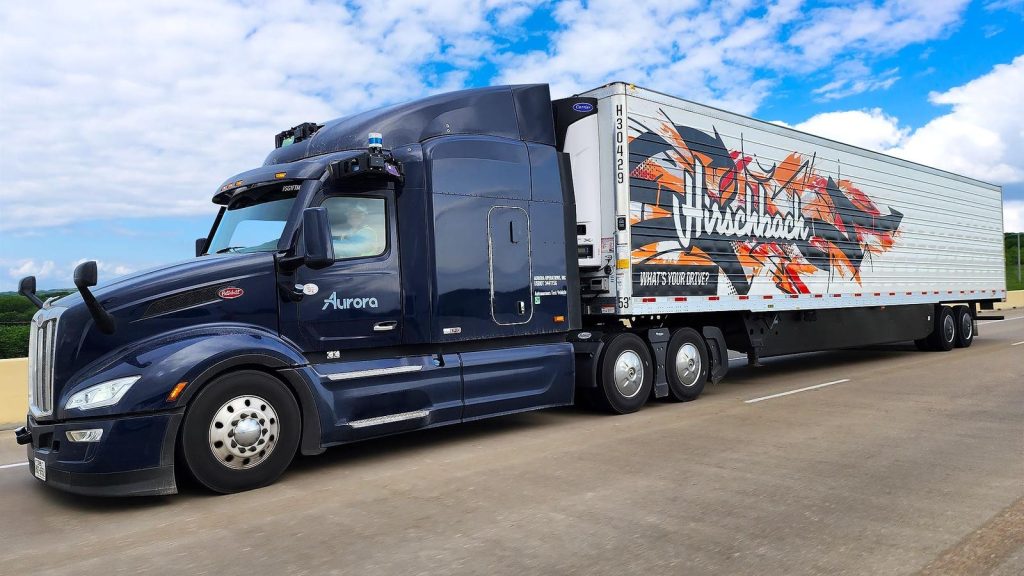We are in an age of mature, commercial autonomy serving society. Cruise Automation is now driving customers in several cities, racking up over 60,000 miles every month. Waymo One has similar numbers, serving over 10,000 trips per week to public riders. Gatik’s short-haul B2B freight operations have been running driver-out since 2021 and the company is now moving goods daily for more than 10 Fortune 500 shippers.
For some use cases, the tech is quite advanced. For others, tech development is still in process. Based on statements from developers, commercial driverless long-haul trucks will be operating next year. What about the freight industry overall? There’s plenty of work to do everywhere you look. Whether it’s more robust technology, new types of freight, new use cases, or geographic expansion, the autonomous trucking space continues to be highly active. Here’s a wide angle look at what’s happening.
Automated Yard Tractors Are Productively Creeping Around
The yard automation space has been quiet for the past few months. That doesn’t mean nothing is happening; its heads-down time for the key system developers in proving out their tech to potential customers.
But! Fresh news arrived this month from Munich-based Fernride regarding their $31M Series A funding round. Fernride’s investors include venture capital firms 10x Founders, Promus Ventures, Fly Ventures, Speedinvest, and Push Ventures along with corporate investors HHLA Next, DB Schenker via Schenker Ventures, and Krone.
In the announcement, Hendrik Kramer, CEO and Co-Founder of Fernride said, “Our current customers operate more than 1,000 yard trucks in Europe alone – it is crucial to offer an easily scalable solution. With Fernride, we can do just that, as our human-assisted approach works right away, solves all the possible edge cases, and delivers the reliability that the industry needs.” Fernride notes that this human-assisted approach “allows for remote takeovers of electric trucks when necessary.”
Fernride has trials underway with Volkswagen, DB Schenker, BSH Home Appliances, and Hamburger Hafen und Logistik AG.
The Fernride website presents videos with their system moving box trailers in a logistics yard, as well as performing container handling in a seaport. When containers are moved, they are dropped onto, and pulled off of, a chassis pulled by the yard truck. In this respect, container moves are less of a technical challenge because there is no need to hook and unhook trailers all day. In logistics yards, hoses and cables must be attached and removed when a trailer is connected to a yard truck, a classically human task. Robotic arms and other techniques have been developed by the AV yard truck players, but achieving the necessary speed and robustness has proven challenging. In fact, achieving this capability is a key competitive discriminator across the offerers.
Short-to-Medium Haul B2B
Gatik’s customer list continues to expand, with a Kroger partnership announced in March. Gatik sources its L4-ready box trucks from Isuzu, based on a longstanding partnership.
Gatik sources tell me they are well financed, with a roughly four-year runway. Further, they note that the company is bringing in meaningful revenue and experiencing aggressive growth. By focusing on an application of autonomous trucking that is constrained (i.e., short-haul, known, repeatable routes), Gatik has established a comfortable place for itself in the nascent AV landscape. To the extent that Gatik customers experience robust operations with Gatik vehicles in short haul operations, their confidence in automated driving for other use cases, such as long-haul, is bolstered.
I’ve said it before and I’ll say it again: this short haul B2B market is too lucrative to have only one autonomous offeror! I have mused that Waymo Via would go strongly in this direction, but their automated trucking program has downshifted and any new moves will come later.
I do wonder about the mysterious new company formed a couple of months ago by Bryan Selesky and Pete Rander. These gents founded Argo.ai in 2016, which was subsequently acquired by Ford and Volkswagen years ago and un-acquired late last year, making headlines as the harbinger of the imminent death of the self-driving trucking dream. Their new company, yet to be named publicly, “is expected to focus on trucking and ride-hailing” according to very thin press reports. Given Argo’s robotaxi focus previously, their tech is tuned very nicely to surface street operations. Moving both people and goods makes sense. The question will be whether they go for B2B (a la Gatik) or B2C (a la Waymo delivering for Uber Eats).
Supplier Partnerships Mean The Go-To-Market Infrastructure Is Taking Shape
All of the driverless truck players are putting supplier partnerships in place to enable go-to-market. Plus recently announced two key deals. A software collaboration brings together Plus’s driver-in solution (“PlusDrive”) and Bosch’s integrated steering system. Additionally, Plus selected Luminar as their exclusive long-range lidar supplier for factory-installed PlusDrive for its commercial vehicle OEM partners.
Tweaking the Tech
The tech across the AV industry is quite mature, but the devil, always in the details, is keeping engineers busy. In the “deal with bad weather” department, Aurora has created an “air knife” to clean rain, ice, bug splatter, and other debris from their sensors. Aurora prefers this approach because air knifing is contactless and invisible, thus avoiding sensor occlusion relating to wipers or other methods.
Where’s TuSimple?
Over the last few months, messaging from driverless truck developer TuSimple has been unclear, to say the least. But according to Freightwaves, earlier this month a TuSimple truck traveled nearly 39 miles on public roads in China, both urban and highway, safely navigating normal traffic with no human occupant or outside help. This article also noted that next year TuSimple is planning a driverless commercial run in Arizona on Interstate 10, where it previously ran several driverless commercial runs in late 2021. In addition, a TuSimple press release announced it has begun 300-mile test runs between Tokyo and Osaka on the Tomei Expressway in Japan.
To my knowledge, this is the first substantial commercially-focused testing activity for AV trucking in Japan. Where will TuSimple pop up next? While these developments are intriguing, their overall strategy remains murky.
It’s Getting Cold Out There
Everyone’s heard about the supply chain, but not everyone’s heard about the cold chain. The challenges of moving around cargo which needs refrigeration creates more complexity than a typical load. Refrigerated autonomous trucks capable of operating at nearly all hours of the day have the potential to move goods in record time, thus increasing the shelf life of fresh produce, driving down the costs of goods for consumers and ultimately leading to fresher food and less waste. The U.S. Department of Agriculture estimates 30-40 percent of nationwide food supply results in the spoilage of perishable goods, which in some cases occurs at various stages of the production and supply chain.
And, the less time the refrigeration unit on the trailer is running, the less carbon emissions are emitted.
Cold-chain shippers are warming up to the potential of driverless trucking. In May,
Aurora Innovation, Inc. and Hirschbach Motor Lines, Inc. began a commercial pilot program to move refrigerated cargo between Dallas and Houston using the Aurora Horizon autonomous trucking service.
Hirschbach, based in Dubuque, Iowa, offers refrigerated truckload services nationwide with their fleet of over 3,000 trucks. Their operations are a mixture of long and short hauls.
“Refrigerated goods need to be delivered in a timely manner otherwise they could spoil in transit and maintaining the proper functioning of the trailer is critical. We’re working closely with Aurora to ensure their operations accommodate this time sensitivity and that they have the proper procedures in place to ensure our refrigerated cooling units in the trailer are fueled and monitored for the right temperature,” said Richard Stocking, co-CEO of Hirschbach, who is also part of Aurora’s Industry Advisory Council.
“This new pilot, on the Peterbilt 579 upfit with the Aurora Driver, demonstrates the increasing maturity of our operations as we expand our product support to a wider number of carriers and shippers,” said David Maday, Senior Vice President, Business Development & Product Strategy at Aurora.
In my interview with Mr. Maday, he noted that “Safely Quickly Broadly” is their guiding star for product strategy. Safety is a given, and customers want access to the tech as quickly as possible in initial deployment regions. After the product is introduced, the Aurora Driver will see successive upgrades, such as the ability to operate in the full range of weather conditions that drivers handle now. This brings geographic breadth, allowing customers to eventually run freight nationwide.
Aurora periodically holds a Customer Summit to elaborate on progress and plans and serve as a listening session. I’m told that their customers at the most recent Summit collectively operate 65,000 trucks, illustrating how the mainstream tech innovators in road freight are taking autonomous trucking seriously.
To emphasize the revolutionary changes brought by driverless trucks, Mr. Maday noted that without driver hours restrictions, a load can travel from Los Angeles to Dallas in a day. And, travel from Dallas to Atlanta in a day. Maybe your kumquats will be just a little bit juicier when driven driverlessly!
Torc Robotics has jumped into the cold-chain as well. Torc and freight carrier C.R. England will implement a pilot program leveraging C.R. England’s temperature-controlled loads and Torc’s fleet of Level 4 autonomous test trucks for long-haul applications. Initial planning will begin mid-2023, with on-road tests soon after.
“Torc is thrilled to be partnering with C.R. England to better improve long-haul trucking safety for one of the premium service providers and largest refrigerated carriers in the nation,” said Peter Vaughan Schmidt, Torc Robotics CEO. “The data derived from the pilot will contribute to our safety and validation efforts and use cases for autonomous trucking.”
“C.R. England is excited to announce our partnership with Torc for pilot activities on Level 4 autonomous test trucks. We believe this innovation will eventually provide the ability to expand our network safely, with high levels of service to our customers, all while enhancing the quality of existing driver jobs,” said Chad England, C.R. England CEO.
Mr. England added that “Torc’s deep integration with Daimler Truck AG makes our two organizations a perfect fit for piloting this new technology.”
A Not-So-Bad Ending
In a positive sign for the AV industry overall, earlier this month Embark was acquired by Applied Intuition for a $71M purchase price. Applied Intuition is not well known outside tech circles but they are known to tech developers. The company offers a range of services and software in simulation, vehicle dynamics, validation and verification, large scale testing, and more. Their customers in the ADAS/AV space include Toyota, Nissan, Einride, May Mobility, Motional, and Torc, and two former automotive CEO’s sit on their Advisory Board. Press reports say that Applied will integrate Embark’s internal tools, data, and software assets to improve its offerings to customers in the trucking and automotive industries, while retaining some key Embark employees.
Kodiak and Loadsmith Lay Out An Ambitious Future
Last month, James Reed, former CEO of USA Truck and now Kodiak’s Chief Operations Officer, shared his perspective on reaching commercialization in a Q&A with Truckinginfo. He said that, for Kodiak, a key technical focus for this year is validating the safety case, i.e., proving that the Kodiak Driver is safer than a human driver in the truck. In parallel, they plan to
stand up “the first commercially operable truck port.” Kodiak has stated for some time now that their target for commercial introduction of their autonomous truck product is 2024.
And just a few days ago Kodiak gave us a peek at 2025! Teaming up with Loadsmith, a leading third-party Capacity-as-a-Service (CaaS) logistics platform for shippers and carriers, the companies say they will equip 800 trucks with Kodiak’s self-driving technology. Kodiak-equipped autonomous trucks will serve as the foundation for the newly established Loadsmith Freight Network (LFN), which Loadsmith calls “the first-ever freight transportation company built specifically for self-driving trucks.”
Additionally, Loadsmith said it will deploy 6,000 trailers on the LFN to maximize the utilization of the Kodiak-powered trucks on the network. The press release noted that, “By pairing self-driving trucks and local manual trucks on the same network, Loadsmith can rapidly scale autonomous deliveries and convert significant amounts of freight volume from traditional trucking methods to a more flexible and on-demand service.”
Brett Suma, Founder & CEO of Loadsmith, said, “Loadsmith’s partnership with Kodiak is founded on the belief that freight transportation is preparing to undergo a profound technological transformation, with autonomous middle-mile trucking leading the way. Loadsmith’s expertise in network design and freight execution combined with Kodiak’s best-in-class autonomous trucking technology demonstrates a new model for how two companies can collaborate to usher in a new era of transportation.”
Kodiak said they will begin delivering trucks equipped with the Kodiak Driver in the second half of 2025. Daniel Goff, Head of External Affairs at Kodiak, explained their initial delivery process this way: “Kodiak will upfit the trucks with the Kodiak Driver, including both autonomy-related components as well as key redundancies on the truck platform itself to ensure a fail-safe system.”
Volvo Autonomous Solutions Is Taking The Leap to Moving Freight
Earlier this month, Volvo Autonomous Solutions (V.A.S.) announced that it opened offices in Fort Worth, Texas, as part of a larger plan to set up the company’s first autonomous freight corridors that will run from Dallas-Fort Worth to El Paso and from Dallas to Houston. To prepare for the eventual self-driving truck operations, in the near term V.A.S. will use trucks operated by human drivers to haul loads for customers including DHL and Uber Freight.
V.A.S. says that they plan to operate on a “hub-to-hub model where autonomous trucks take on the highway portion of the driving, operating all hours of the day and night between transfer hubs while human drivers complete local operations.”
V.A.S is currently accepting “reservations” on their website where “shippers, carriers, logistics providers and freight brokers can secure a priority position to purchase autonomous freight capacity.”
Some time ago, V.A.S partnered with Aurora as part of the autonomous trucking operation plan. Aurora will act as a supplier to V.A.S.
“At Volvo Autonomous Solutions we believe the path to autonomy at scale is through reducing the friction and complications around ownership and operations for customers. This is why we have taken the decision to be the single interface to our customers and take full ownership of the elements required for commercial autonomous transport. With the opening of our office in Texas and start of operational activities, we are building the foundations for a transport solution that will change the way we move goods on highways,” said Nils Jaeger, President of Volvo Autonomous Solutions.
“Through our Autonomous Transport Solution, our ambition is to create a new source of industry capacity that will ease some of the burden of the increasing demand for freight while also enabling local drivers to shift into short-haul jobs that will keep them closer to home. This will unlock significant efficiencies in the entire supply chain and benefit everyone in the transportation industry,” says Sasko Cuklev, Head of On-Road Solutions.
In case the message in these quotes is not coming through loud and clear, allow me to interpret: a truck manufacturer is crossing the boundary from selling their equipment to directly moving freight with their equipment. This concept has been in play for some time in automation circles, but now we have a major truck OEM taking the leap. If this approach takes root, watch out! A lot of established players now running freight are going to wonder where this “freight train” came from to snatch their business away. At the same time, maybe shippers will be dancing in their freight lanes!
Perspective
So that’s my scooping up of the recent goings on in the public sphere. (As always, there is much more happening behind the scenes.)
Fernride’s fundraise and Embark’s acquisition indicate there’s at least a bit of money flowing into the driverless space. Gatik’s four-year funding runway is an indication of the kind of solid ground needed to survive in this space.
A key narrative I’m hearing is that “fleets will have to adapt to driverless.” This means early adopter freight haulers will need to adjust their operations to implement transfer hubs, run in relatively benign regions weather-wise, and figure out what it really means to not have every facet of their operations tied to driver hours. Some of these adaptations will create headaches while others will be liberating. It’s clear to me that there is an ample supply of sophisticated and innovative truck fleets ready to do this.
From this point onwards, the optimally positioned companies will be those that have both substantial sources of cash (venture funding and/or revenue) and a strong procurement play. By the latter, I mean integration and supply partnerships with OEMs and suppliers. Mr. England’s statement above, noting “Torc’s deep integration with Daimler Truck AG” speaks volumes. A major fleet customer wants to have confidence that an offeror of autonomous trucks can deliver the hardware with solid sales and service support.
For developers without a tight OEM partnership, their near-term go-to-market play is to upfit standard tractors. This is do-able but challenging, particularly in terms of added cost. I expect that autonomous-ready Class 8 tractors will be available from OEMs on the open market at some point, but early-on they will prioritize supplying to their existing autonomy development partners.
Who will emerge victorious, actually offering mature commercial products, earning revenue offering Driver-as-a-Service, and ultimately becoming profitable?
Let’s talk about Aurora. For the long-haul space, there is significant bear-ish chatter about these guys. I frequently hear from colleagues (outside Aurora) that the company is teetering on the edge and will run out of cash any day now. My own view is different: simply, no one outside the company can make such an assertion. Aurora’s burn rate relative to commercial deployment and the resulting generation of revenue is indeed the key question. My assertion is that it is very unlikely that Aurora’s leadership (and investors) are asleep at the wheel. Just based on simple logic, they have a plan that they deem viable. This doesn’t mean it will turn out that way, but I just can’t imagine that they’re clueless. When I asked David Maday about this, he was confident about their commercial planning. Referring to Aurora’s key competitors, he noted that “Our independence is our strength, we’re not at the mercy of higher ups like Waymo and Torc are.” There’s always more than one way to look at a situation!
With so many factors at play, my question will have to hang in the air for a while.
Conclusion
While the robotaxis roam, commercial-intent long-haul autonomous trucks are racking up ever more miles. The solid safety metrics being publicized by the robotaxi operators provide a degree of confidence to the freight-moving community about driverless operations in general.
Short-haul is here. Long-haul trucking will come eventually. In contrast to developmental testing over the last few years, the miles that the developers are accumulating now emulate the operations of a released product. As one example, load volume in Aurora’s current pilot is expected to increase to 100 loads per week by the end of this year. Add to this the activity of the other developers and OEMs and we’re talking a very substantial level of miles driven.
This is where we are in mid-2023: across multiple companies, we see a range of use cases, varying types of freight, and rapidly evolving business models. The heterogenous nature of the industry is a key sign of its strength.
Disclosure: I am a strategic advisor and/or hold equity in companies named in this article, including Aurora, Gatik, and Plus.
Read the full article here










